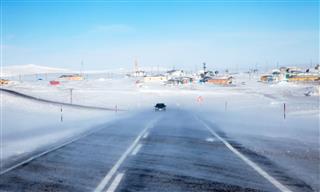
Tornado is a geographical phenomenon that starts on the land surface and is extremely violent. Read this ScienceStruck article to find more about its life cycle.
| Did You Know? The 1996-released film ‘Twister’ was the very first movie to have introduced tornado so closely to common people. Though many movies before it mentioned the term, it was this movie that actually prodded the interest of all. This movie was based on the struggle of a team of storm chasers who wanted to study the tornado or ‘twister’. |
A tornado starts forming when the wind changes its direction with increase in speed, while rising in the upward direction. A spinning effect is caused in the lower atmosphere which is first in the horizontal direction, and becomes vertical due to the rising air within the thunderstorm. This vertical-spinning effect then turns into a violently-rotating column of air, known as a funnel, that moves from the clouds towards the ground. The following elements play an important role in the formation of a tornado.
- Mesocyclone: It is a vortex of air i.e., air rises and rotates around a vertical axis in the low-pressure direction and has a diameter ranging from 2-10 kms.
- Supercell: It is the thunderstorm occurring along with the mesocyclone.
- Rear Flank Downdraft (RFD): It is the region of dry air wrapping around the back of a mesocyclone and is the source of warm air for the mesocyclone.
Life Cycle
Tornado life cycle typically consists of 3 stages :
- Stage 1 – The Beginning: The mesocyclone, along with the RFD, starts moving towards the ground. A small funnel appears to build up at the bottom of a wall cloud. As the RFD reaches the ground, the surrounding dirt rises up, causing damage even to heavy objects. The funnel touches the ground immediately after the RFD, thus forming a tornado.
- Stage 2 – The Lifespan: Its main source of energy is the warm wind inflow which is provided by the RFD. Once it moves for some distance, the RFD becomes cool. The distance it covers depends on the rate at which the RFD cools. If the RFD cannot further provide any more warm air flow to the tornado, it begins to die down.
- Stage 3 – The End: Once its warm air supply is cut, the vortex or the central axis begins to weaken and shrivels away in some time.
As it weakens, the mesocyclone also starts to dissipate. However, a new mesocyclone can start very close to the dying one, thus following the same cycle and giving rise to a new tornado.
Classification
How far a tornado can travel depends on its size. The path of destruction ranges from a few yards to hundreds of miles. The speed of the wind decides the intensity of the tornado. The following table shows the classification based on the Fujita scale.
| Classification | Wind Speed (mph) |
| F0 | 40 – 72 |
| F1 | 73 – 112 |
| F2 | 113 -157 |
| F3 | 158 – 206 |
| F4 | 207 – 260 |
| F5 | 261 – 318 |
| F6 | 319 – 379 |
mph = Miles per hour.
Tornadoes are known by different names in different places. They are more frequent in the United States where they are called twisters. They are called hurricanes in the Atlantic and the East Pacific, typhoons in the West Pacific, and cyclones in the South Pacific, Indian Ocean, and the Bay of Bengal.
Generally, it is believed that a hurricane, typhoon, or cyclone can give rise to a tornado under certain conditions. However, the vice versa is not true for a hurricane, which forms in the water unlike the tornado, that forms only on the land. Most of the tornadoes go through the above phases during their life cycle, but then, there are always some exceptions.







